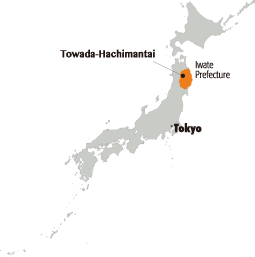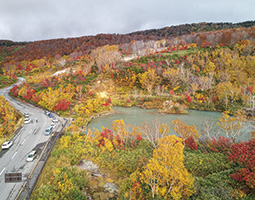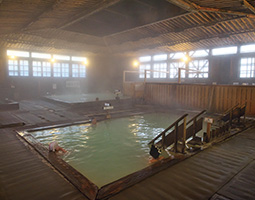Home > Highlighting JAPAN > Highlighting Japan November 2017 > National Parks
Highlighting JAPAN
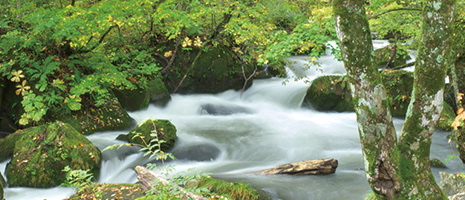
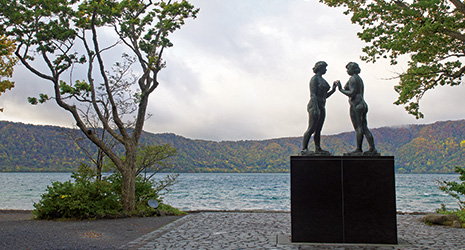
- PREVIOUS
- NEXT
Towada-Hachimantai: A Joy for All Seasons
Towada-Hachimantai National Park, which is blessed with nature, including deep forests, crystalline mountain streams, waterfalls and a lake, is particularly beautiful in the fall when it takes on autumnal hues. But enjoying the magnificent nature to the fullest and soaking in the hot springs are fun activities offered by this national park all year round.
Towada-Hachimantai National Park is a national park located in a mountainous region of northern Honshu (main island of Japan) that consists of mountains, a lake and mountain streams. The National Park has two regions — the Towada-Hakkoda area with Lake Towada, the Oirase-Keiryu (a mountain stream) and the Hakkoda mountain range; and the Hachimantai area with Mt. Hachimantai, Mt. Akita-Komagatake and Mt. Iwate. Located in one of the most prominent volcanic regions in Japan, this National Park offers an attractive combination of topography full of variety and a diverse ecosystem produced over a long period by volcanic phenomena and the heavy snowfall in winter.
Lake Towada is particularly famous in the National Park. It is a double caldera lake formed by volcanic activity that commenced approximately 200,000 years ago. The green of the trees covering the outer crater rim has produced a primeval landscape. Visitors can enjoy this landscape all year round, which is enhanced by additional draping created by a sea of clouds in spring and summer, autumnal leaves in autumn and snow and ice in winter. The “Maiden Statue” that stands on the shore of Lake Towada is a work by Kotaro Takamura (1883–1958), who was a leading sculptor and poet in Japan. Many tourists visit this statue, even though it is located in a secluded lakeside location, because of its high name recognition as a symbol of Lake Towada.
Stretching for about 14 kilometers, a ravine shaped by the Oirase River that starts from the water-rich lake is one of the most preeminent scenic spots in Japan, designated as a special place of scenic beauty and a natural monument by the Japanese government together with Lake Towada. As the area around the ravine is a treasure trove of deciduous broad-leaved trees, the beauty of the ravine is matchless in the season of autumnal leaves in particular, not to mention its grace in spring when the trees sprout leaves and early summer when their leaves grow thick. There is a promenade along the Oirase Keiryu mountain stream. Visitors can stroll along the promenade, admiring the diverse waterfalls scattered throughout, the fantastically shaped rocks covered with moss and the amazing forests of giant trees.
A national road along the ravine is another course covered with trees that offers magnificent views. Visitors can look out over the towering mountains of Hakkoda if they take this course northward. The course is dotted with diverse marshes, including Suiren Marsh surrounded by frost-covered trees in winter and Jigoku Marsh, where hot water with a temperature of more than 90 degrees centigrade gushes out.
The highest peak in the Hakkoda mountain range is Mt. Odake with a height of 1,585 meters. The mountain range spans a group of volcanos from Mt. Takada-Odake and Mt. Akakuradake to Mt. Kushigamine, Mt. Komagamine, Mt. Norikuradake and Mt. Yokodake that continue on to the south. These mountains have mountain trails, and visitors can enjoy panoramic views of a green carpet from spring to summer and a red carpet whose hues change daily in autumn from a ropeway operated all year round.
There are natural forests, fields of alpine plants along mountain ridges and wetlands in the Hakkoda mountain range. They offer diverse views. Visitors can enjoy alpine skiing and admire trees covered in frost in winter after the autumn foliage. Snow walls more than five meters high in areas of heavy snowfall greet them in the New Year. The mountain range is full of landscapes that are graceful and grand.
Additionally, at the foot of the mountains are numerous hot springs, such as Jogakura, Sukayu, Sarukura, Yachi and Tsuta onsens and they have been popularly used for therapeutic purposes. There are various intriguing legends about the discovery of the hot springs, including wounded deer and monkeys found soaking in the hot water. There is also a certain charm to the traditional wooden buildings of Japanese-style inns there.
One of them, the Sukayu Onsen Ryokan (Sukayu Hot Spring Inn), has been visited by many people seeking hot spring cures since the Edo period (1603–1867). This hot spring on a hill surrounded by Japanese beeches about 900 meters above sea level is particularly famous for its hiba sennin-buro (“sennin-buro” means one thousand people bath), a gigantic bathhouse entirely made of Japanese cypress (hiba). There are four bathtubs filled with hot spring water from four different fountainheads in the bathroom, which has a size of a 160 tatami-mat room (265 m2). Visitors can enjoy soaking in these baths on a single-day basis without staying at the Inn overnight.
Such varied pleasures attract sightseers to Towada-Hachimantai National Park all year round.
- PREVIOUS
- NEXT
© 2009 Cabinet Office, Government of Japan
